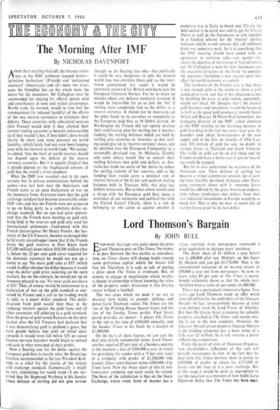Lord Thomson's Bargain
By JOHN BULL
EVERYBODY has kept very quiet about the price ,Lord Thomson puts on The Times. No money is to pass between the two parties as considera- tion, no Times shares will change hands (except some preference capital which the Astors will buy in): Therefore, it is said, to. talk of putting a price upon The Times is irrelevant. But, of course, to engage in negotiations which involve a change in ownership without knowing the value of the property under discussion is like playing soccer without a football.
The two clues which we need if we are to discover how highly in pounds, shillings and pence Lord Thomson values The Times are the size of the Printing House Square losses and the size of the Sunday Times profits. Fleet Street gossip provides an answer: it places The Times in the red to the tune of £300,000 annually, and the Sunday Times in the black by a margin of £1,300,000.
On the basis of these figures, we can cast the deal into strictly commercial terms. Lord Thom- son has acquired 85 per cent of a business making at the moment a loss of £300,000 a year in return for providing the vendor with a 15 per cent stake in a company with profits of £1,300,000 (the Sunday Times contribution) minus £300,000 (The Times loss). Now the Astor share of this £1 mil- lion-a-year company can quite easily be valued. The basis of the calculation. is that on the Stock Exchange, where every form_ of income has a value, earnings from newspapers command a price equivalent to thirteen years purchase.
The Astor share of £1 million a year before tax is £90,000 after tax. Multiply up this figure by thirteen and you get £1,170.A100. That is the conventional valuation of an. income stream ot £90,000 a year net from newspapers. So now we know what 85 per cent of The Times is worth Simple arithmetic shows us that the whole must therefore have a value of just under £1,400,000.
This is not a particularly impressive figure. Two years ago Lord Thomson made an offer worth some £8 million for the publishers of the Glasgow Herald—in fact, unsuccessfully because of some stout defence work by Lord Fraser of Allander. But then Mr Gavin Astor is keeping the valuable property attached to The Times and merely rent- ing it out to the new company. However, the Glasgow Herald group property (George Outram is the holding company) has a book value of a little over £2 million. Son still remains a pretty unflattering comparison.
From the point of view of Thomson Organisa- tion shareholders, reflections of this sort will provide reassurance in view of the fact that the deal with The Times involves them in giving up £195,000 of profits in return for £255,000 ol Tosses—on the face of it a poor exchange. But at this stage it would be quite as appropriate to use the equation as a measure of how badly Lord Thomson thinks that The Times has been man-
aged in the past. Either way, the important point is that Thomson shareholders must be told, pre- sumably when the Monopolies Commission has finished its deliberations, exactly what is involved in the new arrangement. The figures may be modest in size, but the Thomson dividend needs all the extra earnings it can get for it is not well covered. Indeed, without the advantage of invest- ment allowances part of it on last year's figures would have to come from reserves.
Unfortunately, profits in one important part of the Thomson group are moving the wrong way. Last week it was announced that Scottish Tele- vision, in which Thomson now has a 55 per cent stake, would fail to meet the level of earnings forecast at the end of last year when 45 per cent of the equity was floated off to the public. This is serious: Scottish Television is responsible for about a fifth of Thomson Organisation total profits. It is also known that the Sunday Times has been suffering from falling profit margins. So it looks as if regional newspapers, book publishing and magazines will have to make up the gaps.
There is one other reason why there is little room for manoeuvre with the Thomson dividend. Capital spending is clearly at a high level. Start- ing two new local evening papers in the Home Counties is going to cost £2 million. And it is doubtful whether there has yet been much return on the £1 million investment in the new paper in Reading, launched twelve months ago.
So however much one may admire the Thomson Organisation as a manager and promoter of news- papers and kindred publications, now is not the time to buy the shares. Dividend yield is 6.9 per cent with the shares at 20s. 3d. Most of the other comparable groups get a more optimistic rating. Beaverbrook returns you 6 per cent, International Publishing 5.8 per cent, and Financial Times 4.1 per cent. Lord Thomson, as well as Mr Gavin Astor, is under pressure.



































 Previous page
Previous page